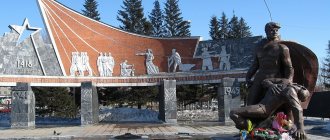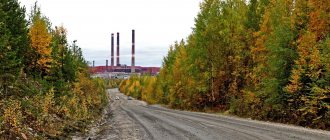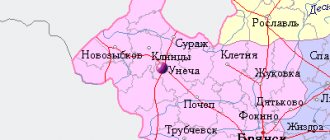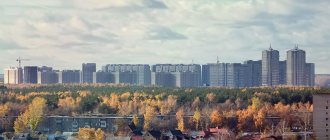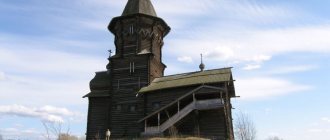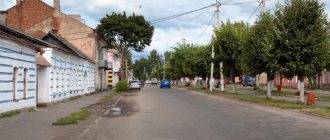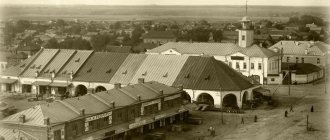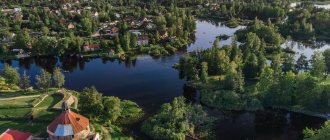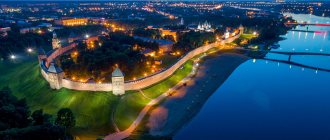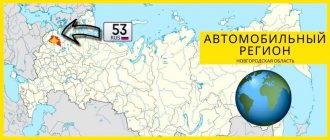Travel to the city of Okulovka. Few people know what beauties the Novgorod land conceals.
We were brought to Okulovka for an unusual reason. The fact is that my friend Artyom and I are big fans of railways. And we especially love small railway lines that branch off from major highways and go into the wilderness. For the sake of travel on such quiet small railway lines, we come up with different trips from time to time. Last year we went to Borovichi to get acquainted with the short line Borovichi - Uglovka, this year we decided to take a ride on another quiet line - Okulovka - Nebolchi. The train runs there only once a week, and on Tuesdays, which made it difficult to organize a trip, since it is a working day. For a long time I waited for both of us to be completely free on some Tuesday, and in August such an opportunity presented itself. A few more comrades were able to go with us, and so we hit the road. Naturally, since we ended up in Okulovka, we also got to know the city itself. And it turned out to be much more interesting than just a junction station from which a side track departs. First of all, it's cute and cozy. Secondly, the nature there is amazing. I was especially pleased with Okulovskoe Lake - large, with clear and clean water! And few people know these beautiful places, without even realizing what beauties the Novgorod land conceals... Therefore, I will introduce my readers to this Russian town, so that they, too, can someday take a walk here. Or at least get to know him through my photographs. Okulovka station. On the right is the main passage, the road from St. Petersburg to Moscow. In the center there is a path for electric trains. And on the left are the tracks for the very road adjacent to the main route along which trains from Okulovka go to Nebolchi. The photo shows a diesel locomotive with the only trailer that will go there. But you will read more about this in another article, where I will talk about our trip from Okulovka to Kulotino. And now about Okulovka itself, where we spent several hours after returning from Kulotin. It was a hot day and it was necessary to take a swim. Therefore, we went towards Lake Okulovskoye, where one of the local beaches is located. It was possible to go to the river, but as it passed through the city it could no longer be clean, so the lake was a more attractive option. Our path was blocked by a black cat, which had no intention of moving at all; in order to give way to someone, we had to go around it to the left. In general, there are a lot of cats in Okulovka, and that’s good! Wooden house with an apple tree. An incredible amount of apples. There are a lot of them here at every step. Civilization ended suddenly - just 15 minutes after we left the station. The houses and streets ended, wild fields began without a hint of the presence of people. It's awesome to live in a city where wildlife is so close to the city! In the summer the road pleases with flowers, there are plenty of them around. In general, where we walked can be called a road very conditionally. On the map it really looks like a road, but in reality everything that leads in different directions is just trampled grass. It is not recommended to walk here without a navigator if you are not local. Such roads may not appear on other maps. If you get to the lake, it will be through a long path that will lead to the far shore. And we took the shortest route, which took only half an hour. We spent the last five minutes walking through the forest. The forests here are quite as nice as ours on the Karelian Isthmus. And noble mushrooms are present in normal quantities. Here we found a white one right on the road. Before this, many mushrooms had already been collected in another Novgorod corner - Kulotin. We went out to Lake Okulovskoye. It turned out to be quite large. Immediately it started to drizzle, and we didn’t get any good photos because the camera fogged up and there was not enough lighting for the smartphone. But we tried to film it somehow to show you the beauty. On the map this place is marked as a beach. But the beach itself is a small entry into the water along the sand and a clearing next to it. Very modest. On the other hand, it is beautiful and cozy. On a Tuesday in the summer there is not a soul on the lake, and for a small company everything is perfect here. But I don’t know what it will be like on a weekend if a lot of locals come. That's the whole beach. I really like such places - nature is not spoiled, there is a lot of greenery, there is no garbage, there are no fire pits at every turn. And at the same time it is very pleasant to swim, because the bottom is sandy, smooth, there is no grass or stones. It’s simply a miracle that nature has been so well preserved near the city! Locals don’t spoil it, and strangers don’t come here to spoil it. And if anyone comes after reading my blog, it will be those who come for beauty, and they will not be able to disturb it. The lake is lucky - it is far from major roads, an evil kebab-maker in a car will not get here. Beauty! And all this is so close to the station, from the city! Incredible! Forest edge near the beach. I was also surprised to see large schools of fish swimming along the beach. They didn’t allow themselves to be photographed, but there were really a lot of them. This is what I managed to photograph - two roach, but in reality there were dozens of roach and perch. The lake is very fishy. The main advantage of the lake is very clean and transparent water! The same as in the best lakes of the Leningrad region! I didn’t expect to find such clear water in these parts; I thought there were lakes only with swampy water. To record the clarity of the water, we take a couple of underwater photos. And this is the author of the blog. Visibility underwater is excellent! The lake is magnificent! Let's go back. There's time to take a closer look at the houses. The main type of buildings are small wooden houses, next to which there is an area enclosed by a fence. Okulovka is very reminiscent of a village. It has been a rural settlement for almost its entire history; it received city status only in 1964. The population now is about 10 thousand people. On the fence, a cat is washing itself with an important air. Unfortunately, a significant part of the city's houses are boarded up. And many of them are already completely dead. When Okulovka became a city, 20 thousand people lived here, now the population is half that, and this process continues. Here, in one frame, there is both a dead house and an unfinished house. City intersection near the station. It should be noted that the initial gloomy impression of the dead houses quickly disappears, because the atmosphere in the city is somehow spiritual and peaceful. The people are all calm, smiling, willing to give advice if you don’t know something, and greet tourists warmly. We saw the same thing in other places in the Okulovsky district. No sadness is felt in them, they love their land, and they are not sad here. This sharply distinguishes the Novgorod region from the Pskov region, where even in the main city of the region everyone has melancholy and hopelessness on their faces. Everything I described above is expressed in the writing on the wall. For every dark night there is a bright day, it says here. This probably conveys what the residents of Okulovka live with. By the way, while walking around the city, I didn’t come across obscene words on the walls (take a walk in Luga in our region - you’ll see a three-letter word there many times a day), but I saw a lot of all sorts of philosophical statements, as well as quotes from poems by famous poets. And here they listen to Tupac Shakur, as can be seen in the same photo - and I also support this. There are no monuments to politicians, leaders, or generals on the main square, as is most often the case in many cities. Not a single monument to bloodsuckers. Everyone who stands here is a cultural or scientific figure. And that's great. This is my ideal - for monuments to stand just like this! The main character here, of course, is Miklouho-Maclay. The famous Russian ethnographer and traveler was born in Okulovka. There is a museum dedicated to him, and ethnography conferences are held here. Near the monument there is a park with benches where it is pleasant to sit and relax. There are no dead houses here anymore, everything is more or less alive and well-maintained. Again, I will note a feature of the Novgorod region, which I have been writing about for years: there is almost no garbage here, the streets are clean and tidy. And people are good-natured, even if they are drunk.
Large residential building near the station. Wood. There are few stone houses here. Here is one of the stone houses. Ancient, with unusual architecture. Pay attention to the unusual windows. The plaque reports that the Russian scientist Yuri Roerich, son of the artist Nicholas Roerich, was born in this house. He was also an ethnographer and traveler. Very close you can see a monument to the scientist. The square in front of the station. An old wooden house opposite the station. Alley along the railway. Everything is very beautiful and cozy. The old Okulovka station, unfortunately, has not survived; it was demolished several years ago, which was a great barbarity on the part of Russian Railways. At the station there is only this railway building. Okulovsky district is distinguished by great patriotism. At the station there is a stand listing the attractions, and there is a website on the Internet with their detailed descriptions. You won't find anything like this in many places. People here love their area very much and are in a hurry to tell everyone about it. I support them in this endeavor, so I will also write about their attractions. Near the station there is a monument to Viktor Tsoi, by which most people remember Okulovka. So, three monuments: one to an artist, two to scientists. And this is good! Why there is a monument to Tsoi, who is a St. Petersburg character, stands here, it is not very clear. There is a legend that once he was traveling somewhere through Okulovka. That's all. I think that the point is simply that here they love his work just as much as here in St. Petersburg. And this also speaks well about Okulovka. Russian rock is alive, hurray! Well, now let's go look at the ancient church located at the end of the square. This is the Church of Alexander Nevsky. It took us a while to figure out how to get past the fence that encloses the temple, but a local woman immediately rushed to tell us how to get around the fence. I repeat once again that the locals here are friendly and helpful. By the way, not far from the church there is a pie shop where you can find delicious and inexpensive pies. It is interesting that the temple began to be built in the name of St. Nicholas, but was eventually consecrated in honor of Prince Alexander Nevsky. Local merchant Ivan Zubov donated a significant amount for the construction of the temple. The temple was built in 1901, under Emperor Nicholas II. In 1937, Stalin began a real massacre among priests, exterminating almost all of the clergy in Russia. Temples were closed en masse throughout the country. This church was also closed. They made a cinema inside. The height of the bell tower is 12 fathoms, which in modern units of measurement would be 25.6 m. Therefore, it is clearly visible from afar. In 1993, the dilapidated temple was returned to believers. Gradually it regained its blooming appearance. Before the revolution, an almshouse was built near the temple, where a dozen and a half old women and old men lived out their lives and were cared for there. At that time, churches often engaged in charitable activities. Beautiful bell tower. Monument to the victims of political repression. In small towns, those killed by communist executioners are well remembered. And this memory should not disappear so that this never happens again. On the other hand, they remember the liquidators of the Chernobyl accident. Beautiful temple! I went to the station. I met only one worker inside, and he was sleeping with his head on his paw. There is no one at the frames at the entrance to the station building, and this makes me happy. At least here they don’t spoil people’s mood by simulating concerns about safety. The waiting room is small. But there is a coffee machine and toilets, so the station is comfortable. A year ago we were at a similar Uglovka station - it was just empty, no waiting room, no service, but there were guards. Here it's the other way around, and it's nice. Let's go to our train. We return to St. Petersburg by two different “Swallows” - one on the “Swallow” from Bologoe, the other on the Moscow one. On the way we make a stop in Malaya Vishera. And there I photograph the old station. There was once a similar one in Okulovka.
Original
History of the formation of Okulovka and the Okulovsky region
As a settlement, Okulovka was formed through the gradual merging of nearby villages (including the village of Okulovka) into one territory. Some of these villages are known from the scribe books of Derevskaya Pyatina since 1495 - these are Okulovo, Obrechye, Peretno, Berezovik, Parakhino, etc.
Archaeological monuments allow us to trace the history of the appearance of people here long before our era. For example, near Okulovka on the shore of Lake Zaozerye, scientists discovered the site of a Neolithic man. That is, people lived here more than 5 thousand years ago. Scientific research carried out on the territory of the Okulovsky district also indicated that the most populated place in the region was the district of the modern villages of Zaruchevye, Bor, Nizovka (Borovenkovskoye settlement). Here archaeologists found a significant amount of slag (a by-product of iron smelting from swamp ore), as well as a pit filled with large pieces of the ore itself, which indicates that people were engaged in iron smelting, and therefore the importance of their access not only to the immediate surroundings, but also communication with distant lands, which contributed over time to the development of the territory of the modern Okulovsky district.
As a result of scientific excavations carried out by N.K. Roerich, S.N. Orlov, V.Ya. Konetsky and other scientists, the replacement of settlements of Finno-Ugric tribes with Slavic settlements was traced. Since those distant times, some of the geographical names have come down to us.
A large burial mound from the 7th–10th centuries has been preserved on the shore of Lake Okulovskoye. In the 15th century, this lake, as well as the Khvoshchenka River, were well developed by man. Mounds VI-IX were preserved in the forest near Kamoki (the area of the Furniture Factory). There are many traces of human habitation (mounds, hills, zhalniks) near Kulotin and Polishch, in the vicinity of Lake Borovno and other places.
In the old days, administrative centers were churchyards. This was the name of the territorial districts, which united nearby villages and included a church standing away from the main village with an adjacent cemetery and housing for clergy. Pogosts have been known since the 10th century: in 947, “Olga went to Novgorod and established graveyards and tributes on Msta.” It must be assumed that Princess Olga established administrative centers, first of all, on large tributaries of the Msta, which was Shegrinka. This is how, for example, the Shegrinsky churchyard arose. It also included the lands on which the city of Okulovka was subsequently formed.
In the 15th century, on the shore of Lake Sitno (the area of the modern village of Skovorodka of the Turbine settlement) there was a Sitensky churchyard (it was a “nourishing” region). Also known are Yazvischsky, Polishchsky, Terebunovsky, Vysokoostrovsky and other churchyards, the area around which has long been inhabited by people. All of them belonged to the Derevskaya Pyatina of the Novgorod land.
In the same 15th century, the territory within the boundaries of the modern Okulovsky district was partially included in the Lokotsky, Ruchyevsky, Oksochsky and Chernchevitsky churchyards (now these are the lands of the Malovishersky, Krestetsky and Bologovsky districts of the Novgorod region).
After the annexation of Novgorod to the Moscow State (late 15th century), over the next two centuries, two systems of territorial division simultaneously existed: the old Novgorod system (by Pyatina) and, characteristic of the Moscow State, by districts. Thus, the lands of the future Okulovsky district belonged to the Derevskaya Pyatina of the Novgorod district. Since the beginning of the 18th century, the territory in question was part of two districts of the Novgorod province: Borovichsky and Valdai, and since 1776, also in Krestetsky.
From the first half of the 19th century, in connection with the formation of military settlements in the Novgorod province, volosts began to be created, which united only state-owned villages and therefore were not territorial, but administrative and economic units. The lands within the borders of the modern Okulovsky district belonged to Kayovskaya, Zaruchevskaya, Zaozerskaya, Shegrinskaya, Borovenskaya and other volosts.
It should be said that for many centuries the Novgorod region was characterized by small, 1-3-yard villages - farmsteads or manors (estates). The following hamlets are known to have existed in the Okulovsky region for a long time: Orekhovno, Dorishchi, Glushino, Krestovnikov hamlet - Sipyagina manor, etc.
The policy of consolidating villages began in the 17th–18th centuries in connection with the enslavement of the peasantry and received a logical continuation in Soviet times. By now, many of the previously existing villages and hamlets have disappeared. In the Valdai National Park, the idea is being hatched to install memorial signs for future archaeologists on the site of disappeared settlements.
Three centuries (XVI, XVII and XVIII centuries) due to the loss of archival materials are a blank spot in the history of the Okulovsky region. One can only guess about the lives of people in these times. The most important event of the 19th century was the construction of the St. Petersburg-Moscow railway in 1843–1851, which gave impetus to the emergence of station O. Gradually, people began to flock here, which led to the development of the nearby territory. The first inhabitants of Okulovka were 12 families of Arkhangelsk Pomors and peasants from neighboring villages, as well as railway workers, merchants from Borovichi, Krestets and Valdai, workers and artisans.
Capital entrepreneurs and foreign investors drew attention to the favorable position of Okulovka. Thus, industrialist V.I. Pasburg founded a paper factory in 1856 in the village of Obrechye near the station. In 1875–1882, in Kulotin, the head of the southern border customs guard from Odessa N. Bardashevich (according to other sources - Bardecheev) built a factory for the production of sack cloth, which operated until the end of the 20th century.
Peasants from distant villages, especially after the abolition of serfdom in 1861, flocked in search of work closer to the railway and established enterprises and populated the station and its surroundings.
The picturesque places in the O. region and the convenience of its location attracted the attention of secular society, which led to the emergence of numerous noble estates.
The origin of the name Okulovka is most likely related to the name Okul. It has long been customary in Rus' to name settlements, wastelands, and farmsteads by nicknames and names. It is possible that Oculus was the name of the first settler of these places. This name (nickname) has now fallen out of use, but it is worth remembering its well-known variants - the female name Akulina, the epic Mikula, the Ukrainian Vakula, etc. Among the old-timers of the O. r. There is also a beautiful legend that there was an amazing bird with huge wings in these places - the huge eagle Oculus.
According to other versions, the origin of the name Okulovka is associated with words consonant with it, having “kul” in the root part. For example, among the Turkic peoples, “kul” means a slave or servant. Translated from Tatar “kultuk” means corner, dead end. It is possible that in these places, for example, in the area of the modern village of Kulotino, whose name is also consonant with Okulovka, there was an extreme point for the collection of tribute by the Tatars. In the Russian language there is the word “kul” (bag, impressive bundle), and therefore the etymology of the word “kulak” (prosperous owner) is clear. The consonance of the toponym Okulovka with the words “school”, “okolotok”, etc. can also be traced. Unfortunately, there is no final solution to the name of the city yet.
History of the formation and development of Okulovka
If we refer to the “List of populated places in the Krestetsky district of the Novgorod province” for 1879, then at that time the population of the Okulovka station in the Zaozersk volost was, according to parish information, 1,146 people. There were 200 buildings here, of which 140 were residential. There were 10 shops, 5 drinking houses, 1 wine warehouse, 4 taverns and 1 Rensk cellar. Estates and houses were built by 8 landowners, 5 contractors, 20 merchants, 5 priests, 15 policemen.
In 1909, at the Okulovka station, 205 courtyards, 257 residential buildings were noted, where 888 men and 828 women lived. By this time, there had appeared a school, an almshouse, a postal and telegraph office, a zemstvo horse station, 2 railway workshops, a small brick factory by F.P. Resh, 3 inns, and the Sinilshchikov tavern, where Ukhari merchants, charlatans and peasants met small money was acquired, as well as 29 shops (bread, manufacturing, meat, shoe, etc.). Later (1910-1914) a merchant club appeared.
In 1909, 2 restaurants operated in Okulovka. One of them was located at the railway station, the other was owned by the merchant Franz Petrovich Resch. He also owned a two-story wooden house on the Kavkaz site (where the steep descent of the highway now begins from the former Novobank) where a hotel was located. According to the assessment of 1903, this house cost 2,318 rubles, and 7 outbuildings with it - 492 rubles. The total area of the estate of F.P. Resh was 1,156 square fathoms. Rows of birch alleys led to a well-appointed bathhouse on a pond. It is noteworthy that Franz Petrovich’s house has survived to this day.
At the beginning of the 20th century, F. P. Resh founded a small brick factory in Okulovka. In 1909, 20 workers were employed here and there was a horse-drawn press for molding bricks. In 1913, the company produced about 80 thousand bricks during the summer season. Of these, in particular, a merchant club was built in Okulovka. During the years of Soviet power, around 1923, the plant resumed work in the system of the Leningrad Regional Housing Administration. The number of workers varied from 40 to 60 people, and a second horse-drawn press appeared. In 1932, 550 thousand bricks were produced here during the summer season. By 1938, the enterprise was transferred to the Raipromkombinat. During the Second World War it was destroyed.
Adjacent to the Okulovka station was the village of Okulovka, a settlement, a churchyard and the estate of the actual state councilor Konstantin Aleksandrovich Sipel (Sippel), which previously belonged to his father-in-law Ivan Dmitrievich Sergeev, on whose lands the Okulovka station was founded in the mid-19th century. The station also included the villages of Opechki and Kholmy, located in the area of modern Kommunarov Street. Here in 1909 there were 68 residential buildings, 228 residents, a school and a state-owned wine shop.
In 1909, in the village of Okulovka there were 39 households, 185 people lived, and there was a chapel and a shop. In the settlement (the area of modern Pochtamtskaya and Slavnaya streets) in 1909 there was a small zemstvo hospital with one doctor, a school, a post office, a shoe workshop, a bakery and several other shops. 141 people lived there. In the churchyard (the territory of the modern market) there are 10 residents, an apartment for the bailiff and the zemstvo elder and two churches - an old wooden one, transported in 1865 from the village of Mshentsy, Valdai district, and a stone one, built in 1901 (see Churches of the Okulovsky district: Alexander Church Nevsky in Okulovka). In the estate of K. A. Sipel, which stood slightly to the side of the modern Truba railway crossing, in 1909 11 people lived in 3 residential buildings.
The management of the Okulovka station and its surroundings was carried out by the zemstvo chief. He was also a judge. Subordinate to him were the headman, the constable, 15 guards and 3 gendarmes. There was no electricity in Okulovka at that time, kerosene lamps were burning in the houses, and the streets were not illuminated at all. There was no transport to serve the population, with the exception of horses owned by private individuals. But hiring a cab driver was very expensive. Every Sunday and on religious holidays a large bazaar was held on the main square of Okulovka. Every year on September 8 (old style) the Bogoroditskaya fair was held.
By 1918, 4 thousand people lived at Okulovka station, and a little more lived in the area of the working-class village of Parakhino, which is now part of the city of Okulovka.
The “List of populated places of the Novgorod province of Krestetsky district” for 1879 provides the following information about the village of Parakhino. There were 45 buildings here, 33 of which were residential. They made up 16 peasant households (including 4 households of peasants), and “1 household was from a different class.” The village included a paper factory, 2 small shops, a drinking house and 2 estates, where 16 people lived in 5 houses. In total, according to family lists, 46 men and 43 women lived in Parakhino. And according to parish lists - many times more: 325 men and 142 women. This can be explained by the large influx of newcomers who worked at the paper factory “without registration.”
In terms of age, the population of Parakhin looked like this: “up to 8 years old - 5 boys and 5 girls, from 8 to 13 years old - 60 boys and 22 girls, from 13 to 18 years old - 105 boys and 53 girls, from 18 to 60 years old - 153 men and 58 women, over 60 years old - 2 old men and 4 old women.” Such a demographic imbalance indicates the social disadvantage of the local population and the widespread use of boys, boys and men from surrounding villages in the factory.
On the left bank of the Peretna River there was the village of Elagino, where 19 people lived in 7 houses, and the Novinka estate of F.I. Shats, where 5 people lived. This is the area of the birch grove famous today. In the village of Poddubye of the Parakhinsky rural society, 29 people lived in 12 houses, and in the estate next to it, 7 more people lived in 2 houses (in 1909 - 15 people, 5 residential buildings). Most likely, this estate belonged to the manager of the stationery factories S.F. Franke. But there was also the Poddubye estate of V.P. Podushkin, where 2 residents were noted in 1909.
By 1909, in the vicinity of the village of Parakhino, workers’ settlements of the Upper and Lower stationery factories arose, the villages of Poddubye, Novinka, Kamoka, Novoye Parakhino appeared, whose residents supported themselves by working at the enterprise of V.I. Pasburg. Later, by merging these villages, as well as the villages of Elagino, Shurkino, Obrechye, Soinka and others, the village of Parakhino was formed.
According to the “List of Populated Places of Krestetsky District” for 1909, at that time in the vicinity of the Upper Stationery Factory there were 14 residential buildings, where 99 people lived. There was a school, a hospital, and a police station here. In the village of Nizhnyaya Stationery Factory, 30 people lived in 3 houses. By this time, 14 houses had been built in the village of Novoye Parakhino, with 40 residents. In the factory village of Kamoka (Chepukhovo), which appeared in connection with the founding of the timber industry, 96 people were noted in 30 houses. By 1909, the village of Elagino had also grown greatly, where instead of 7 houses there were now 71, and the population had grown to 209 people. The emerging workers' settlement of Poddubye in 1909 consisted of 120 residential buildings, where 357 men and 394 women lived.
If in the “List of populated places of Krestetsky district” of 1879 there was only one Novinka estate with 5 inhabitants, then in the “List” of 1909 the Novinka estate O. N. Shats (2 houses, 40 people), the Novinka estate (Yurkovo) O. are listed. N. Shats (2 houses, 14 people) and the village of Novinka F. I. Shats, where 225 people lived.
As we can see, the population of Parakhin and the surrounding area gradually grew and by 1918 amounted to more than 4 thousand people. The appearance of the village also changed.
In pre-revolutionary times (around 1879), the distance between the Okulovka station and Parakhin was 4.5 km. On both sides of the stone-lined road connecting them there was a dense forest. People traveled to their destination on foot or in cabs. Since 1911, when the railway line from Okulovka to Poddubye station came into operation, transportation of all goods (for example, to the paper mill of V.I. Pasburg) began to be carried out by horse-drawn vehicles of the large private owner Kuzmin. His equestrian yard consisted of hundreds of bull horses and occupied the territory on the left bank of the Peretna River, below the now existing Obrechenskaya dam. All trade in Parakhin was concentrated in the hands of merchants: I. A. Stepanov, Balagurov, P. S. Stekolnikov and Messrs. Resh. They set the prices for goods themselves.
Merchant Ivan Alekseevich Stepanov, process engineer and manager of the paper mill of V.I. Pasburg, lived on the banks of the Peretna River in a stone two-story house, opposite which he built a stone chapel. It is known that in the 20s of the 20th century, an elementary school was located in his house (“Stepanovskaya School”). And later, for a long time (until 2002), there was a clinic. Today this building has been renovated and houses a hotel. There is also a funeral services store in the chapel. There is evidence that the son of I. A. Stepanov, Sergei Ivanovich (b. 1893), worked as an engineer at the Okulovsky paper mill. In 1937, he was arrested and sentenced to 10 years in the camps.
The house of Prokofy Stepanovich Stekolnikov was considered the largest in Parakhino at that time. Nowadays, it housed a post office, telegraph, savings bank, legal consultation and a number of other organizations and institutions. Recently, the house of P.S. Stekolnikov was dismantled.
In the area of the “Old Store” there was an estate Otradnoye of Messrs. Resh, where in 1909 4 people lived. The Reshs ran a bakery and a small grocery store. In Okulovka they owned a restaurant, a hotel and a small brick factory (see above). Next to the Otradnoye estate there was the Otradnoye dacha of Maria Petrovna Resh (sister of F.P. Resh - the owner of a hotel and restaurant in Okulovka), where there were 6 residents. Someone from the Resh family also owned the Trakhnovo estate, which stood three miles from the Okulovka station in the Donets wasteland (somewhere in the area between Okulovka and the village of Vasilkovo in the Berezovik settlement, if you go by rail). There was 1 residential building noted here, in which 6 men and 4 women lived.
It will be interesting to know that Parakhino is mentioned in A.P. Chekhov’s travel notes “Sakhalin Island” (“Egor’s Story”), where the writer tells about the crime of the convict Egor - a peasant, a native of the Okulov region, serving exile on Sakhalin. Having gone with a friend to a tavern in Parakhino (presumably it was a beer shop that stood on the land of the hereditary nobleman V.P. Podushkin in Poddubye), he got drunk and became involved in a fight, during which a man was killed. In all likelihood, Yegor did not commit a crime , and took the blame upon himself at the request of the men. He was sentenced to 10 years of hard labor and transported first to the provincial prison in Novgorod. Then the party of prisoners was transported by train to Odessa, and there they were put on a ship bound for Sakhalin - the place of exile of the convicts.
A.P. Chekhov learned about this story from Yegor himself, having visited Sakhalin from July to October 1890. Interested in the life of convicts, the writer then talked with them and even kept a card for each one, in which he indicated the name, surname, occupation and corpus delicti of the exile. Based on the collected material, Anton Pavlovich subsequently wrote the book “Sakhalin Island,” which included “Egor’s Story.” And although it does not indicate the surname of the convicted Okulov peasant, it became known from the data of the Chekhov card index - Efremov. Currently, census cards of exiles compiled by Anton Pavlovich are stored in the Lenin Library and in the Central State Archive of Literature and Art in Moscow. A photograph of the card registered to Yegor Efremov was published in the 10th volume of the 12-volume collected works of the writer (M., 1984. - P. 105, 224, 339, 585, 16).
After the revolution of 1917, Okulovka and its surroundings were part of Malovishersky, Borovichsky, Valdai and Bologovsky districts. The Okulovsky district was first separated in 1927 as part of the Borovichi district of the Leningrad region. At that time it occupied only part of the modern territory. Other parts belonged to Uglovsky and Torbinsky districts.
In 1928, Okulovka received the status of a workers' village and in 1930 became the administrative center of the district. After the Torbinsky district was included in the Okulovsky district in 1931, and the territory of the Uglovsky district in 1932 was divided between Okulovka, Borovichi and Bologoe station, the Okulovsky district gradually took shape in its modern form. This finally happened after the Great Patriotic War.
In December 1964, the Novgorod Regional Executive Committee decided to merge the working villages of Okulovka and Parakhino-Poddubye into the city of Okulovka. The decision was approved by the Decree of the Presidium of the Supreme Soviet of the RSFSR on January 12, 1965. From now on, this date is considered the city’s birthday.
Main milestones in the development of O.:
1928 – Okulovka received the status of a workers’ village.
1930 – Okulovka received the status of a regional center within the boundaries of the former Zaozerskaya volost.
1932 - Okulovka became a regional center approximately within its current borders.
1936 – a monument to S. M. Kirov was erected (in the park behind the Alexander Nevsky Church).
1937 – the Alexander Nevsky Church in Okulovka was converted into a sound cinema “Rodina”.
1965 – the villages of Okulovka and Parakhino-Poddubye were formally united and transformed into the city of Okulovka. In order to eliminate the same street names in the united city, a number of streets were renamed. The main street of Okulovka (Sovetov Street) began to be called Lenin Street.
1966 – a department store opened on the street. Lenin. Extensive work is planned for the electrification of the Okulovsky district.
1967 - a new State Bank building was built on N. Nikolaev Street (corporatized and transformed into the former Novobank in 1991).
1968 - The Okulovsky Radio Products Plant was born with the launch of a turning section in the premises of the former State Bank on Lenin Street. Until 1980, the plant was a branch of the Leningrad Production Association named after. Kozitsky.
1966–69 – a bakery was built.
1969 – the Yunost Hotel opened, designed for 80 beds (Kirova St.).
1972 – the first stage of the new multi-storey production building of the radio products plant came into operation. A dairy plant was built on Magistralnaya Street (opposite the radio products plant). In the village of Beryozovka (Uglovskoe settlement), an obelisk was unveiled to fellow countrymen who died during the Second World War.
1973 – the Administration building was built.
1974 – the Ekran cinema opened (with 300 seats). A road works management system has been created. Large-scale work has begun on asphalt paving of city streets.
1975 – the building of the sanitary and epidemiological station, the House of Household Workers and the base of the Okulovsky Electric Networks Enterprise were built on the street. Magistralnaya.
1976 – construction of the medical building of the central regional hospital began.
1979 – a park was laid out on the arrow of Lenin and K. Liebnecht streets.
1980 – through traffic was opened on the street. Magistralnaya.
1986 – the printing house building was built.
1989 – founded on the basis of Selelectro.
1991 – a new building for secondary school No. 1 was built (N. Nikolaev St.).
1993 – the building of the A. Nevsky Church (children and youth sports school) was again transferred to the Orthodox.
1994 – the corporation “Seven Brooks” began its work.
1995 – the enterprise “Industrial and commercial charitable company “DIV”” was created.
1996 – a monument to N. N. Miklouho-Maclay and an exhibition in the local history museum dedicated to the outstanding traveler were opened.
1998 – gasification of the city began: natural gas was supplied to the apartments of Okulov residents.
2001 – construction of a new railway station and surgical department of the Central District Hospital began.
2003 – the OLES LLC wood processing plant was built.
2004 – the passenger part of the new station came into operation. The courthouse was reconstructed. A pharmacy has been opened (Adept-Pharm LLC – Lenin St., 36A).
2007 – a park opened near the railway station. A monument to Yu. N. Roerich was erected. A network of cellular radiotelephone base station towers and a car wash were built on the street. Magistralnaya.
2008 – a 120-apartment building was put into operation (Ostrovsky St., 58). The Karsar LLC shopping complex was built on Lenin Street. On the street Miklouho-Maclay opened the “Expert” store and the “Elite” fashion store.
2009 – the building of the Communications Center of OJSC North-West Telecom was put into operation on Ostrovsky Street. Residential buildings in the area (R. Luxemburg St., Griboedova St.), as well as in the city center (Miklukho-Maklaya St.) are being supplied with gas.
2011 – a new Novobank building was built (Kirova St.)
2012 – a five-story medical building of the Central District Hospital opened.
Country of Divas: Encyclopedia of the Okulovsky region / Author - comp. E. N. Romanova, L. E. Bricker; Ed. M. S. Kukina, E. N. Tumanova; Under the general editorship. A.I. Belinsky. – St. Petersburg: Publishing house “DUMA”, 2014. – 544 p.: ill.
The city of Okulovka is the administrative center of the Okulovsky municipal district of the Novgorod region. Located on the Peretna . The city is located 150 km from Veliky Novgorod, 249 km from St. Petersburg and 400 km from Moscow. Railway station - Okulovka.
The area of the city is 2641.9 hectares. The population of the city in 2012 was 12,548 people.
The very first written evidence about the villages of the Okulovsky region is available in the Census quitrent book of Derevskaya Pyatina, compiled at the end of the 15th century (around 1495) for the purpose of calculating quitrent. The lands on which the settlement arose and its surroundings then belonged to the ancient Polishchensky churchyard of Derevskaya Pyatina. So, like Valdai, Okulovka has every opportunity to celebrate its 500th anniversary.
The roots of Okulovo names, as in many places, go back thousands of years. Okulovka and Kulotino have the root “kul” - in Russian “kul-kul” - a large bag, an impressive bundle. Hence “kurkul”, “kulak” - a wealthy owner, the Russian “kulovery” - schismatics. It turns out that the names of the villages Kulotino and Okulovka are essentially the same root words. Thus, Okulovka is the penultimate point for collecting quitrent, the final Kulotino, which means okulo (i.e., about). There is also a version that has documentary evidence that the Nikolaevsky railway station Okulovka at 229 versts is named the same as a small village - the village of Okulovka. As the ancient Russian name book explains, various nicknames were widespread in Rus'. They were often used to give names to populated areas, wastelands, farmsteads, and settlements. Perhaps Okulovka was named after the nickname of Okula, the first settler in this place.
The emergence in the past of the village of Okulovka , and now the city, dates back, according to local old-timers, to the time immediately following the construction of the Nikolaev railway, i.e. after 1851. Familiarization with the existing city plan confirms this information: the direction of the main streets exactly follows the direction of the railway line. Before the construction of the railway, on the site of the village there was only the estate of the landowner Sippel.
A village began to be built on the southern outskirts of the station, and its first inhabitants were 12 families of Arkhangelsk Pomors. Foreigners also appreciated the advantageous geographical location. Foreign investors willingly settled in the region. The Gora estate was furnished by the Duke of Leuchtenberg. I. Vakner built a modern mill near the village of Pochep.
In 1856, in the village of Parakhino, on his land four miles from the Okulovskaya station, industrialist V.I. Pasburg founded a stationery factory, which initially produced wrapping paper from rags and rope supports. A little later, at the confluence of the Khorenka and Peretna rivers, the Kulotinsky factory for the production of sack fabric, founded by professor of medicine N. Bardashevich, arose.
The station village of Okulovka began to grow rapidly. In the shortest possible time, a small brick factory, Resha, was built, employing 20 people. The depot with two registered locomotives went into operation. Eight landowners, five contractors, twenty merchants, five priests, and fifteen policemen built estates and houses in the village. A merchant club, a four-year railway school, a parochial school, and a commercial school appeared (1910).
2 churches of St. Nicholas the Wonderworker (1901) and a wooden Church of the Virgin Mary , transported from the village of Mshentsy, were built, an almshouse and a Peasant's House were erected. A small zemstvo hospital with one doctor was also built.
Okulovka and the area were not captured by the enemy, but for more than two years they experienced all the hardships of front-line difficulties. Hard work almost around the clock, frequent bombings and reconstruction work.
In 1952, on the basis of the lower wood-pulp plant in Kamok, the construction of the Kamok Furniture Accessories Plant began. Agriculture is also developing successfully. Civil construction was carried out - multi-storey buildings appeared in Okulovka; a House of Culture was built, a paper mill with an auditorium for 780 seats, a club named after. Dzerzhinsky - 250 seats, House of Pioneers, 5 libraries, 2 stadiums. The city's population had 2 clinics and 2 hospitals, a railway dispensary; 3 health centers, 2 pharmacies.
By a decree of the Presidium of the Supreme Soviet of the RSFSR dated January 12, 1965, Okulovka was given the status of a city; it was formed as a result of the formal administrative merger of the villages of Parakhino-Poddubye and Okulovka-1.
In 1996, a monument to N. N. Miklouho-Maclay and an exhibition in the local history museum .
2004 In September, the passenger part of the new railway station came into operation. Okulovka.
The administrative building on Oktyabrskaya Street was reconstructed. The largest recreation center for youth is opened there - the Relax restaurant, a bank, a chain of stores, etc.
Some of the city's attractions include:
1. Railway station complex
- station building
— depot building 1850. Owned by the Oktyabrskaya Railway State Enterprise and used as a station and depot, the condition is emergency and unsatisfactory
2. Hospital building : XIX centuries. Owned by the Central District Hospital, clinic at the address - Okulovka, st. Kalinina, 62. Condition is unsatisfactory
3. Commercial school building . N. Nikolaev, a hero of the anti-fascist underground in 1917 and 1930s, studied here. Belongs to the Central Bank State Administration for the Novgorod Region, Sberbank, Okulovka, st. Kirova, 9, Condition - satisfactory
4. House of I. Soin. End of the 19th century. Belongs to JSC "Vesna", not used, emergency condition, Okulovka, st. Lenina, 31
5. Zolotarev’s House End of the 19th century. Belongs to the Okulovsky branch of Novgorodtelecom, telegraph, unsatisfactory condition. G. Okulovka, st. Lenina 32
6. Church of Alexander Nevsky 1900 Novgorod Diocesan Administration, by appointment, satisfactory. G. Okulovka, st. Lenina 33
7. Almshouse building, 1900. Novgorod Diocesan Administration, parochial school, satisfactory. G. Okulovka, st. Lenina 34
8. Merchant club building. End of the 19th century. Committee for Youth Affairs, Culture and Sports, Library and House of Culture, G. Okulovka, st. Lenina 51
9. Stationery factory : 1908 JSC “Okulovsky wallet”, Okulovka, Parakhino village, production premises
9.1 Main building 1908, 1923 JSC “Okulovsky wallet”, Okulovka, Parakhino village, production premises
9.2 Mechanical workshop 1927, XX century, JSC “Okulovsky wallet”, Okulovka, Parakhino village, production premises
9.3 Warehouse 1930, 1952 JSC “Okulovsky wallet”, Okulovka, Parakhino village, production premises
10 F. Shan's estate 2nd floor. XIX century District administration, building management No. 1. Unsatisfactory. G. Okulovka, st. Soviet
— Manor house Housing. Unsatisfactory
— Regularly landscaped park (2 hectares). Unsatisfactory.
11 The building of the surgical building of the regional hospital , founded by the surgeon V. Besser (1889-1956) 1856, 1929 Okulovskaya Central District Hospital, surgical department of the Central District Hospital, satisfactory. G. Okulovka, st. Kalinina, 125
12 Cemetery of Soviet soldiers 1942 Administration of the Okulovsky district. Burial, satisfactory. G. Okulovka, st. Kalinina
13 Cemetery of participants in the civil war and Soviet party activists of 1920, 1939. Administration of Okulovsky district. Burial, satisfactory. G. Okulovka, st. Kalyaeva, communist cemetery
14. Cemetery of Soviet soldiers, 1943. Administration of the Okulovsky district. Burial, satisfactory. G. Okulovka, st. Kalyaeva, communist cemetery
15. Building. In which the elections of the Council of Workers', Soldiers' and Peasants' Deputies of 1918-1924 took place. House management No. 1, housing, satisfactory, Okulovka. St. Lenina, 28
16 Cemetery of Soviet soldiers 1941-1944 Administration of Okulovsky district. Burial, satisfactory. G. Okulovka, st. Lenin at the association "Robok" DRL
17 Mass grave of Soviet soldiers 1941-1944. Administration of Okulovsky district. Burial, satisfactory. G. Okulovka, st. Lenin. Civil (old) cemetery
18. Mass grave of Soviet soldiers 1941-1944. Administration of Okulovsky district. Burial, satisfactory. G. Okulovka, st. Lenin. Civil (old) cemetery
19. The house in which the hero of the anti-fascist underground N. Nikolaev (1918-1942) lived, lived in 1930-1939. Private ownership, housing, satisfactory. G. Okulovka, st. N. Nikolaeva, 9
20 The building in which the first Council of Workers' and Soldiers' Deputies of the Zaozersk volost was located, 1917. House management No. 1, housing, satisfactory. G. Okulovka, st. Novgorodskaya, 10
21 Grave of I. Tolstopyaty, workers' correspondent of the provincial newspaper "Zvezda", killed by enemies of Soviet power 1925 JSC "Bumazhnik", burial, unsatisfactory, Okulovka, st. Oktyabrskaya
22 The building of the school where the hero of the Second World War, pilot D. Parfenov (1919-1941) studied, 1930s RONO, school. Satisfactory, Okulovka, st. Parfenova, 32
23 Cemetery of Soviet soldiers 1941-1944 Administration of Okulovsky district. Burial, satisfactory. Okulovka, civil cemetery (new)
Okulovsky District Municipal Museum of Local Lore named after. N.N. Miklouho-Maclay is located in Okulovka , st. Lenina, 50. The museum is open daily from 10.00 to 17.00, except Sunday and Monday.
On the eastern side of the city there is a protected natural landscape and a lake. Okulovskoe .
Telephone code: +7 81657
City and district website: www.okulovka.com
State Enterprise Administration website: www.okulovka-adm.ru
Okulovka
Church of Alexander Nevsky in Okulovka
Okulovka was first mentioned in the scribe book of the Derevskaya Pyatina of the Novgorod land around 1495 (refers to the Polish churchyard). Since 1851, railway station of the Nikolaev Railway.
In 1856, a paper mill was built on the banks of the Peretna River in Okulovka. The first sulphite cellulose plant in Russia was an enterprise built here in 1883 by the “Partnership of Okulovsky Stationery Factories V. I. Pasburg”. Due to the large volume of production of Okulov factories, the use of cheap hydropower, and the low price of root wood, the cost of wood pulp production at these enterprises was the lowest in Russia. The cost of 1 pood of Okulov wood pulp at the beginning of the 20th century. was 70 kopecks, while the average cost at Russian factories was 1 ruble. per pood. The successful entrepreneurial activity of V.I. Pasburg in the field of the pulp and paper industry began somewhat by accident. In 1856, he, the owner of Moscow sugar production enterprises, bought on the river. Peretna, Krestetsky district, a “completely undeveloped” small paper factory for the production of sugar loaf packaging. The efficient use of energy from the Peretna River, the convenient transport location of the factory and the qualified management of a paper production specialist, factory director E. F. Reiner, ensured further prosperity and leadership in the pulp and paper industry. “The Partnership of Okulovsky Stationery Factories V.I. Pasburg” was one of the largest Russian associated landowners (in 1914). Until the end of 1926, Okulovka was the center of the Okulovsky volost of the Malovishersky district of the Novgorod province, and since 1921, including the North-Western region , which included the entire territory of the Novgorod province. Since January 1, 1927, Okulovka has been the administrative center of the Okulovsky district of the Borovichi district of the Leningrad region. By the decision of the Presidium of the All-Russian Central Executive Committee of June 25, 1928, the settlements of Okulovka and Parakhino-Poddubye were transformed into workers’ settlements. With the formation of the Novgorod region on July 5, 1944, both villages, like the entire Okulovsky district, became part of it. From April 1963 to January 1965, both villages were part of the Malovishersky industrial region.
In December 1964, the Novgorod Regional Executive Committee decided to merge the working settlements of Okulovka and Parakhino-Poddubie into the city of Okulovka
. The decision was approved by the Decree of the Presidium of the Supreme Soviet of the RSFSR on January 12, 1965. This date began to be considered the city’s birthday[3].
